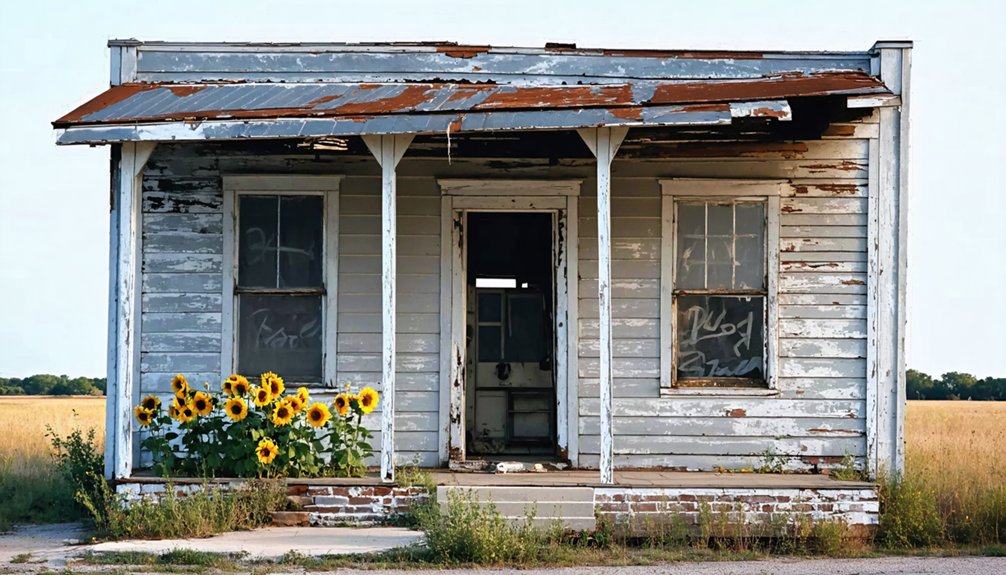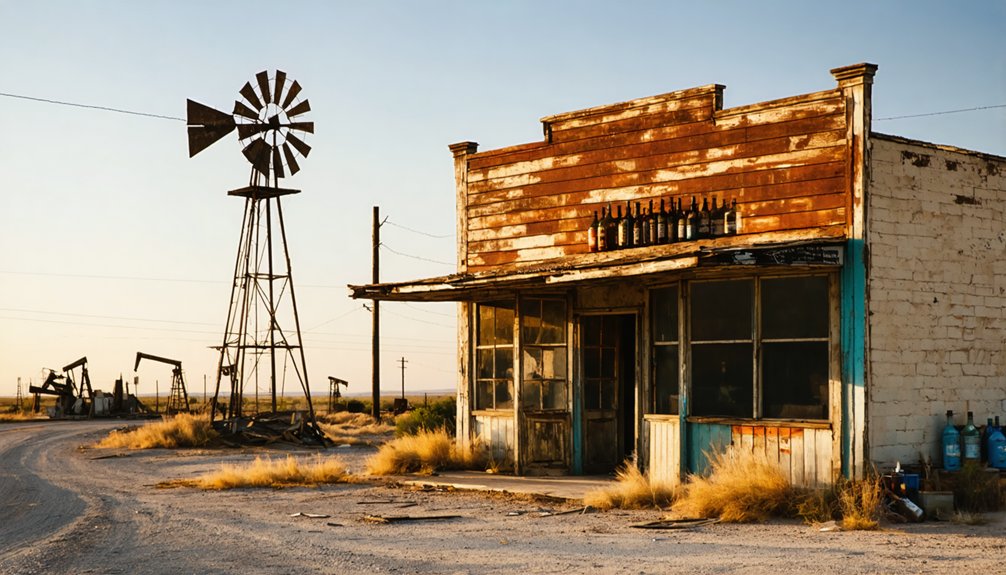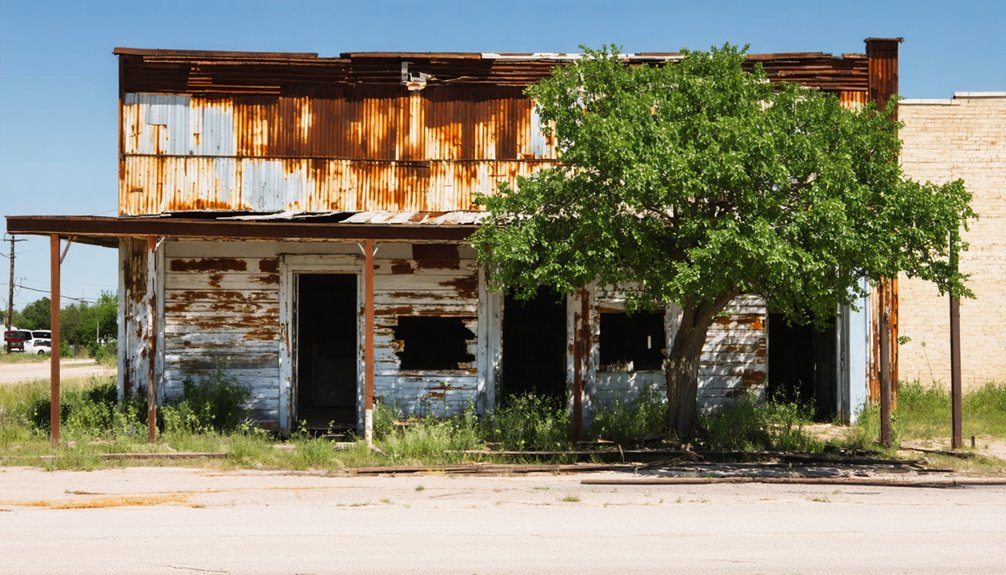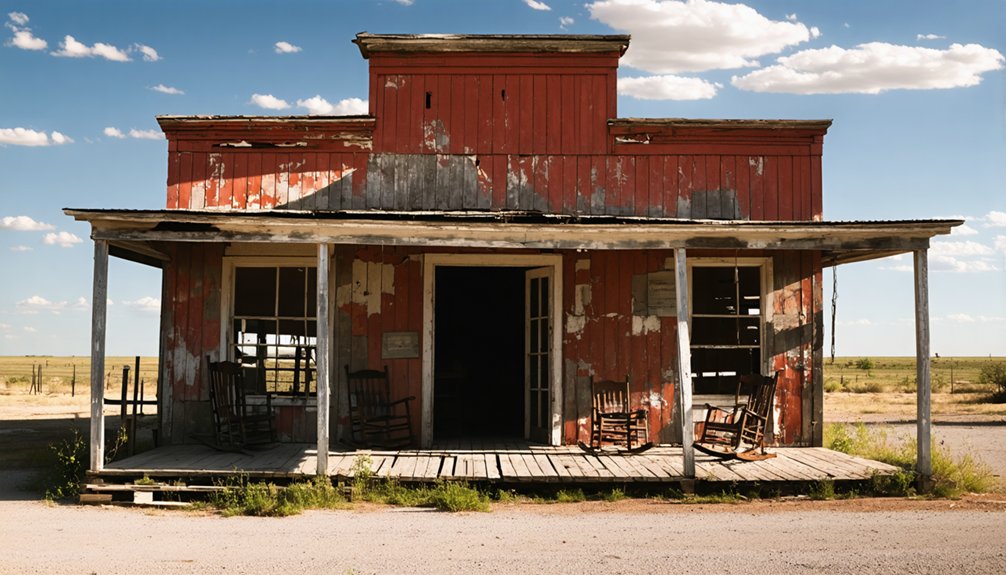You’ll find Jimkurn’s remnants in Texas’s oil country, where it burst to life during the 1920s Panhandle oil boom. This short-lived boomtown swelled to 3,500 residents after three major oil discoveries in 1924, with wells producing at 1,350 feet deep and land leases hitting $3,000 per acre. The town operated a crucial post office from 1920-1926, serving as both mail hub and social center, before declining into ghost town status. Jimkurn’s fleeting story captures a pivotal chapter in Texas’s oil frontier.
Key Takeaways
- Jimkurn emerged as a boomtown during the 1920s Texas oil rush, growing to 3,500 residents by 1925 after major oil discoveries.
- The town’s infrastructure developed rapidly with temporary housing, a post office, and railway connections to support the growing oil industry.
- Economic decline began when oil production decreased, causing workers to leave and businesses to close their doors permanently.
- The post office’s closure in 1926 marked Jimkurn’s transformation into a ghost town, following the typical boom-and-bust pattern of oil towns.
- Historical markers and county archives preserve Jimkurn’s legacy as a testament to Texas’s oil boom era and pioneering families.
The Birth of a Boomtown
When oil was discovered in the Texas Panhandle during the 1920s, Jimkurn emerged as one of many bustling boomtowns that dotted the region’s landscape. You’d have witnessed the rapid transformation as prospectors, roughnecks, and fortune-seekers flooded into this strategic railway outpost, creating a wild frontier atmosphere that defined boomtown culture.
The town’s character shifted dramatically as its transient population swelled. Initial geological expertise from Amarillo had indicated promising signs of oil deposits in the region. Local residents lived in tents and shacks while seeking their fortunes in the oilfields. You would’ve found yourself among a primarily male crowd of oilfield workers, with makeshift housing and hastily constructed businesses springing up to meet their needs.
Like its neighbor Borger, Jimkurn’s development was driven by the promise of quick wealth, attracting both legitimate entrepreneurs and questionable characters who shaped the town’s early identity as a raw, energetic frontier settlement.
Origins of the Jimkurn Name
The origins of Jimkurn’s distinctive name remain shrouded in mystery, with several compelling theories vying for historical authenticity.
You’ll find a fascinating blend of indigenous influences and linguistic evolution woven into the fabric of this East Texas ghost town‘s identity.
Consider these primary theories behind the name’s origins:
- It’s likely derived from a local indigenous word, though its exact meaning has been lost to time.
- The name might be an anglicized version of a Native American phrase, transformed through generations of oral tradition.
- Early settlers’ surnames could have morphed into “Jimkurn” through frontier record-keeping.
- The name possibly emerged from a combination of personal names and geographic descriptors common to Texas frontier settlements.
Records from the 19th century show various spellings, reflecting the dynamic cultural intersections of Native American and Anglo settler communities in an era when towns like Lone Star Institute drew families seeking quality education. Much like the story of Plemons Crossing, where a reliable river crossing point established a community’s foundation, these frontier towns often emerged around essential services.
The Texas Oil Rush Connection
You’ll find Jimkurn’s story closely tied to the East Texas oil boom of the early 20th century, when oil discoveries transformed countless rural settlements into bustling boomtowns.
Like many of its neighbors, Jimkurn experienced rapid growth as oil workers, speculators, and supporting businesses flooded the area, creating a temporary but vibrant community centered around petroleum production. The region saw significant oil production from wells drilled at depths of 1350 feet. Similar to other towns in the region, land lease prices skyrocketed to $3,000 per acre as the oil rush intensified.
The town’s eventual decline mirrored the common pattern of oil rush settlements, with its population and infrastructure gradually disappearing as oil production shifted elsewhere in the region.
Rapid Rise and Fall
During the early 20th century’s Texas oil boom, Jimkurn emerged as a quintessential boomtown, springing up almost overnight amid the Panhandle’s frenzied oil exploration.
The town’s rapid development reflected hasty urban planning focused solely on supporting the oil industry’s immediate needs. Like Thurber’s transition during the oil-fired locomotives era, Jimkurn’s economy proved vulnerable to energy market shifts. Similar to Mingus, the town became known for its ten whiskey joints that catered to the oil field workers.
You’ll find Jimkurn’s dramatic trajectory marked by four distinct phases:
- Swift population surge as oil workers and speculators flooded in
- Rushed construction of basic infrastructure and temporary housing
- Peak prosperity driven by oil production and railway connections
- Sharp decline when production waned and newer fields drew workers away
The community dynamics shifted from bustling to broken as the mono-industrial economy couldn’t sustain itself.
When oil prices fluctuated and nearby discoveries lured away capital, Jimkurn’s fate was sealed, leaving behind abandoned buildings and deteriorating infrastructure.
Oil Wealth Fuels Growth
Three major oil discoveries near Jimkurn in 1924 transformed this once-quiet Panhandle outpost into a prosperous boomtown, mirroring the explosive growth seen across Texas during the oil rush era.
You’d have witnessed the rapid influx of workers, investors, and entrepreneurs who flooded the area, enthusiastic to capitalize on the economic impact of the oil boom.
Similar to Otis Chalk, the discovery of oil on nearby ranch land sparked intense development and speculation.
The town’s prosperity quickly manifested in new infrastructure and amenities.
You’d have found freshly built hotels, churches, and gambling halls alongside essential services that catered to the surging population.
The town’s population swelled to more than 3,500 by 1925 as oil production peaked.
The railroad’s arrival further accelerated growth, connecting Jimkurn to crucial supply lines and oil transport networks.
Like many Texas boomtowns of the 1920s, Jimkurn’s fortunes rose dramatically as oil wealth poured into local businesses and development projects.
Daily Life During Peak Years
Life in 1920s Jimkurn centered around the rhythms of oil production and railway schedules, with the town’s 150 residents adapting to the demanding pace of a Texas boomtown.
You’d find worker routines dictated by the harsh realities of oil field labor and railway operations, while social hubs like local saloons offered brief respites from the grueling work.
Living in this remote west Texas outpost meant:
- Working long shifts at drilling sites or railway stations
- Returning to simple, functional housing built for utility rather than comfort
- Gathering at makeshift community spaces during precious off-hours
- Dealing with limited amenities and services typical of isolated boom settlements
Your daily existence would’ve been shaped by the town’s industrial character, where transient workers sought opportunity amid the challenges of frontier life.
The Post Office Era: 1920-1926

During Jimkurn’s brief peak, you’d find the post office serving as the town’s central communication hub, where residents gathered daily to collect their mail and exchange news.
Your letters and packages would’ve traveled along the Wichita Falls and Southern Railway line, connecting Jimkurn to larger regional centers through established rural mail routes.
If you lived in Jimkurn between 1920 and 1926, you’d have joined your neighbors at this essential community collection point, where the postmaster sorted incoming mail into designated boxes and processed outgoing correspondence.
Postal Service Daily Operations
While Jimkurn’s post office operated between 1920 and 1926, its daily functions proved crucial to the town’s social and economic fabric.
You’d find the small facility serving as a significant link in the region’s postal routes and communication networks, connecting residents to the outside world through a steady flow of letters, news, and parcels.
- Daily sorting began with incoming regional mail, ensuring proper distribution to enthusiastic townspeople awaiting news from distant family.
- Money order services enabled miners and workers to send funds home safely.
- Record keeping tracked every piece of mail received and dispatched.
- Mail carriers coordinated closely with staff to deliver along local routes.
The post office wasn’t just about mail – it became a social hub where you’d catch up on local news while handling your postal business.
Mail Routes Between Towns
As Jimkurn established its post office in 1920, the town became a vital node along the Wichita Falls and Southern Railway‘s mail routes.
You’d find mail connections flowing through Jimkurn’s railway station, where trains would stop to load and unload parcels bound for destinations across Texas and beyond. The rail logistics were precisely timed to sync with train schedules, ensuring efficient mail transfer between towns.
From 1920 to 1926, you could count on Jimkurn’s post office to serve as both a passenger station and mail exchange center, linking remote areas to larger postal hubs.
The town’s position along the railway made it an important part of the region’s mail network until 1926, when changing transportation trends and route consolidations led to the post office’s closure.
Community Mail Collection Point
The establishment of Jimkurn’s post office in 1920 brought crucial mail services to this isolated Texas community.
You’d find this modest wooden structure serving as a crucial hub for community connectivity and rural commerce during its six-year operation.
The post office strengthened Jimkurn’s independence through:
- Daily handling of letters, parcels, and money orders for miners and ranchers
- Creating a central gathering point where you’d exchange news and information
- Supporting local businesses by enabling communication with distant suppliers
- Providing crucial government services like official document processing
As a symbol of Jimkurn’s legitimacy, the post office anchored the town’s identity until 1926, when declining population and shifting regional dynamics led to its closure, marking a turning point in the community’s fate.
Economic Rise and Fall

Founded in 1920 as a railway station and post office along the Wichita Falls and Southern Railway, Jimkurn’s economic trajectory followed a brief but typical pattern of rural Texas boom-and-bust development.
As a transit point, you would’ve found the town’s early prospects tied closely to the railway’s promise of connecting local agricultural producers to broader markets.
The town’s economic sustainability faced significant transportation challenges when it failed to secure connections to major highways or develop industries beyond railway servicing.
Without diversification, you’d have witnessed Jimkurn’s fortunes decline as agricultural mechanization reduced labor needs and railway traffic diminished.
The closure of the post office marked the final chapter in Jimkurn’s economic story, and today you’ll find little evidence of its brief commercial life beyond scattered remnants of its railway past.
Legacy in Stephens County
Pioneer families and early settlers shaped Jimkurn’s enduring legacy within Stephens County’s rich historical tapestry. Historical preservation efforts have kept the memory of this ghost town alive through carefully maintained records and local chronicles.
Today, you’ll find Jimkurn’s community identity preserved through:
- County archives housing detailed genealogical records of the area’s founding families
- Historical markers commemorating the town’s location and significance
- Local oral histories passed down through generations of Stephens County residents
- Place names that honor early settlers and reflect the region’s cultural heritage
The town’s story lives on through Stephens County’s commitment to maintaining its historical records, ensuring that Jimkurn’s contribution to the area’s development won’t be forgotten in the pages of Texas history.
Modern-Day Ghost Town Status

While Jimkurn’s historical legacy endures through county records and local chronicles, its physical presence tells a different story today.
You’ll find a landscape that exemplifies classic ghost town dynamics: dilapidated structures, overgrown grounds, and an absence of basic utilities or municipal services. The site stands as a stark reminder of rural depopulation trends that have affected numerous Texas communities.
If you’re exploring Jimkurn now, you’ll encounter the challenges typical of abandoned settlements – unclear property titles, fragmented land ownership, and deteriorating infrastructure.
The town’s current state reflects broader economic shifts that have impacted many Texas ghost towns, with no active residential or commercial activity.
While some Texas ghost towns have found new life through tourism or preservation efforts, Jimkurn remains largely untouched by modern development initiatives.
Frequently Asked Questions
Were There Any Major Crimes or Lawlessness Reported During Jimkurn’s Peak Years?
You won’t find documented crime statistics or law enforcement records showing major crimes in Jimkurn. Even typical frontier issues like saloon brawls or cattle rustling aren’t recorded in available historical sources.
What Happened to the Original Buildings and Structures After Abandonment?
You’ll find abandoned structures decaying from weather damage, vandalism, and neglect. Most buildings lost their roofs and fixtures, while others were dismantled. Only scattered ruins remain with minimal historical preservation efforts.
Did Any Notable Historical Figures Visit or Live in Jimkurn?
You won’t find any documented historical visitors or notable residents in Jimkurn’s short existence. Like 250+ other Texas ghost towns, it remained a basic railway stop without attracting any famous personalities.
What Was the Highest Recorded Population of Jimkurn During the Boom?
You won’t find exact population records during Jimkurn’s boomtown dynamics, but based on similar Texas ghost towns’ population growth patterns, it likely peaked at no more than a few hundred residents.
Were There Any Schools or Churches Established in Jimkurn?
You’ll find no documented school history or church significance in available records, though similar Texas ghost towns typically had them. Direct evidence of these institutions in Jimkurn remains unconfirmed.
References
- https://mix941kmxj.com/the-strange-sad-story-of-a-texas-ghost-town-youll-never-visit/
- https://www.youtube.com/watch?v=PsuLwAQ12QI
- https://en.wikipedia.org/wiki/List_of_ghost_towns_in_Texas
- https://texashistory.unt.edu/explore/collections/TGTN/
- https://www.texasescapes.com/TexasTowns/Jimkurn-Texas.htm
- https://www.texasescapes.com/TOWNS/Texas-Ghost-Towns-5-Texas-Panhandle.htm
- https://yesterdaysamerica.com/texas-oil-history/
- https://www.legendsofamerica.com/tx-borger/
- https://www.geoart.com/wichita-county/
- https://texasarchive.org/power



